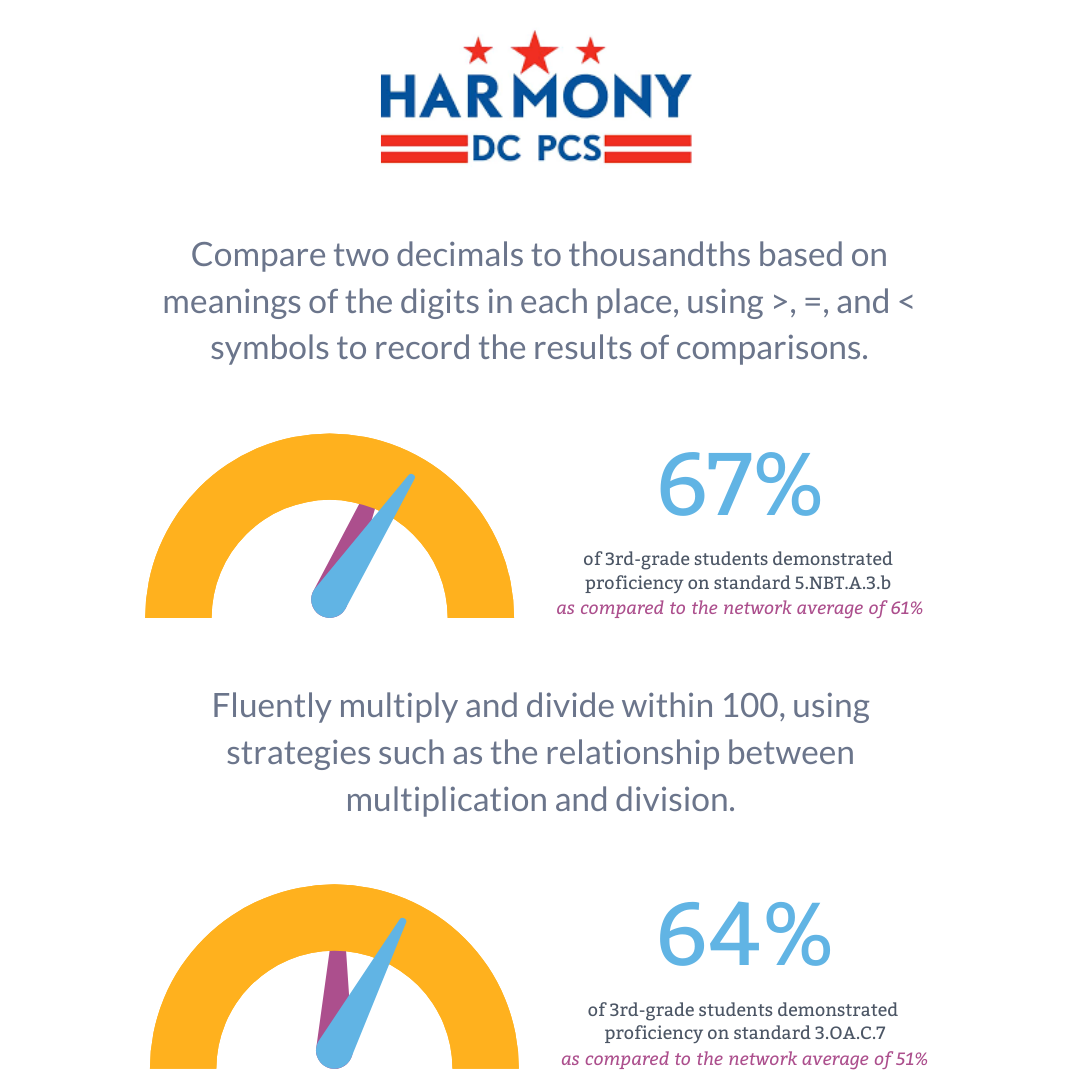-2.jpeg?width=193&height=259&name=Phyllis%20Shepherd%2c%20Harmony%20DC%20PCS%20Dean%20(1)-2.jpeg) After spending nearly two decades in the classroom, Washington, D.C. educator Phyllis Shepherd transitioned to a school leadership role at Harmony D.C. Public Charter School at the start of the 20-21 school year. With a strong background in mathematics as a result of her long career as a math teacher, interventionist, and intervention coordinator, Shepherd was excited to use her wealth of educational knowledge and experience as Harmony’s newest Dean of Academics.
After spending nearly two decades in the classroom, Washington, D.C. educator Phyllis Shepherd transitioned to a school leadership role at Harmony D.C. Public Charter School at the start of the 20-21 school year. With a strong background in mathematics as a result of her long career as a math teacher, interventionist, and intervention coordinator, Shepherd was excited to use her wealth of educational knowledge and experience as Harmony’s newest Dean of Academics.
The transition wasn’t without its obstacles, though.
In addition to the many unexpected challenges that Shepherd would face alongside other school leaders as they navigated a global pandemic and its impact on education, she also found that she initially struggled to find her voice as a leader. Many of the teachers at  Harmony had been in the classroom as long as she had before becoming Dean, which led to some self-doubt and second-guessing, she says. Veteran school leadership across the world have struggled to lead effectively throughout the pandemic, so as a first-year leader Shepherd was learning to lead in some of the toughest conditions known to educators, an undoubtedly daunting task.
Harmony had been in the classroom as long as she had before becoming Dean, which led to some self-doubt and second-guessing, she says. Veteran school leadership across the world have struggled to lead effectively throughout the pandemic, so as a first-year leader Shepherd was learning to lead in some of the toughest conditions known to educators, an undoubtedly daunting task.
Over the last year and a half though, Shepherd has truly blossomed as an educational leader.
Dr. Anita Walls, Harmony’s ANet coach, says that Shepherd has “really taken [ANet’s] coaching and run with it.” At the start of this school year, Walls reached out to Shepherd to begin planning for Harmony’s first formative assessment window only to find that Shepherd had already begun to analyze student data and plan independently, a huge feat for someone in only their second year of school leadership. Walls says that this growth in Shepherd’s capacity as an educational leader has been truly inspirational to witness and to be able to support.
Shepherd attributes much of her growth and success as an educational leader as well as Harmony’s overall growth and success to their partnership with ANet, which began shortly before Shepherd moved into her new role.
Rather than a coach, Shepherd describes her relationship with ANet’s Dr. Walls as a mentorship. She says, “I don’t think I would have been able to do any of this [without ANet]. ANet really helped me to find a… place where I could finally launch [as a school leader.]” While Harmony had a lot of great systems and structures already in place ahead of their partnership, Shepherd believes that ANet’s guidance has helped them “push a button” and accelerate student achievement in their building by enabling them to identify the highest-impact areas to focus on as a school rather than trying to do “everything.”
Shepherd also points to her frequent use of myANet–ANet’s online suite of tools and resources for teachers and leaders–as a source of her increased confidence and capacity as an instructional leader.
She says, “I don't even close the window because I know that I'm going to use [myANet] every single day.” She spends much of her time in the Standards Tab to ensure that she fully understands all parts of the standard that are being taught in the classrooms she observes. She also engages with sample questions and high-quality tasks ahead of instructional walkthroughs to ensure that she knows exactly what level of rigor to look for. After walkthroughs, she has learned to use Student Achievement Partners’ Instructional Practice Guide to identify the “biggest bang for your buck items” that her teachers can focus on to ensure that their students are able to receive daily access to grade-level, standards-aligned content.
Harmony has particularly benefited from ANet’s de-siloed approach to coaching math and literacy leaders.
Given her decades-long career as a math teacher as well as extensive experience in analyzing and acting on student data during her tenure as an interventionist, Shepherd initially felt considerably more confident about her abilities as an instructional leader in mathematics. Literacy, though, presented a new challenge for her.
-3-1.jpeg?width=297&height=297&name=DeVaughn%20Montgomery%20DC%20PCS%20(1)-3-1.jpeg) By working alongside her ANet coach as well as Harmony’s ELA Department Chairperson and Reading Interventionist DaVaughn Montgomery, though, Shepherd was able to recognize some of the commonalities between math and literacy instruction as well as gain a greater understanding of the ELA standards and the importance of daily reading and writing for her students. She was also able to see connections between grade levels that she previously didn’t recognize. Montgomery says, “[Ms. Shepherd] really has come a long way in terms of her knowledge base around literacy, because that wasn’t her focus [before.]”
By working alongside her ANet coach as well as Harmony’s ELA Department Chairperson and Reading Interventionist DaVaughn Montgomery, though, Shepherd was able to recognize some of the commonalities between math and literacy instruction as well as gain a greater understanding of the ELA standards and the importance of daily reading and writing for her students. She was also able to see connections between grade levels that she previously didn’t recognize. Montgomery says, “[Ms. Shepherd] really has come a long way in terms of her knowledge base around literacy, because that wasn’t her focus [before.]”
Shepherd’s growth as a leader is especially evident in the ways she works “shoulder to shoulder” with her teachers, supporting backward planning and lesson internalization, creating weekly assessments, and conducting data analysis. This year, in particular, she has worked with teachers at Harmony to prioritize student voice and discourse in classrooms and to ensure that students are shouldering the cognitive lift. As a result of Harmony’s increased focus on student discourse, students are able to clearly articulate their thinking both verbally and in writing.
Partnership with ANet is boosting the instructional leadership capacity of teachers and leaders alike at Harmony.
Abike Dedo, a 2nd/3rd grade ELA teacher, says her practice as a classroom teacher has been transformed by the tools and resources that ANet offers and that she has “gained much insight from the professional learning experiences, specifically our training on equitable instruction.” She regularly looks through ANet’s resources on close reading and rewatches screencasts on text complexity as she works to ensure that all of her students have access to grade-level, equitable teaching and learning.
the tools and resources that ANet offers and that she has “gained much insight from the professional learning experiences, specifically our training on equitable instruction.” She regularly looks through ANet’s resources on close reading and rewatches screencasts on text complexity as she works to ensure that all of her students have access to grade-level, equitable teaching and learning.
DeVaughn Montgomery appreciates the wealth of knowledge that his ANet coach brings to the table; he says that Dr. Walls regularly uses the power of the ANet network to point him toward resources from partner organizations. He also uses ANet passages regularly for close reading with students as well as to create high-quality question stems that ensure that students are doing the majority of the cognitive lift in text-based discussions.
These practices are positively impacting student data.
At their fall data meeting, Harmony staff elevated and celebrated student wins across each of the grade levels at Harmony. Some of their biggest celebrations were in 3rd-grade math, where students outperformed their peers within the network of schools that follow the same schedule of assessed standards as Harmony. In 4th grade ELA, teachers and leaders were excited to see that their students performed on par with the network in certain standards, given that their 4th-graders have often struggled due to the huge shifts that occur between 2nd/3rd grade versus 4th/5th grade.

As fourth-year partners, Harmony’s gains in their instructional leadership capacity in both teachers and educational leaders have been compounded yearly; by continuing to partner with ANet, they are able to build each year on the growth from the year prior and see long-term gains toward equitable teaching and learning practices. As they continue their multi-year partnership with ANet, teachers and leaders alike are excited to see evidence of continued growth in both students and educators at Harmony D.C. PCS.
